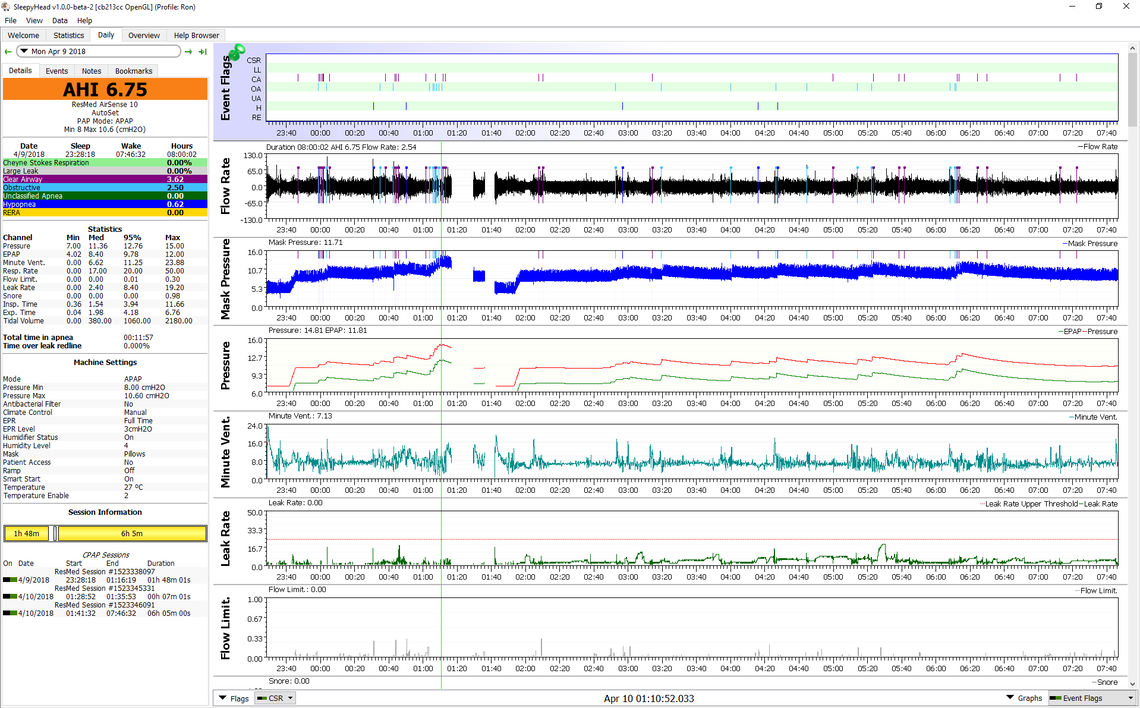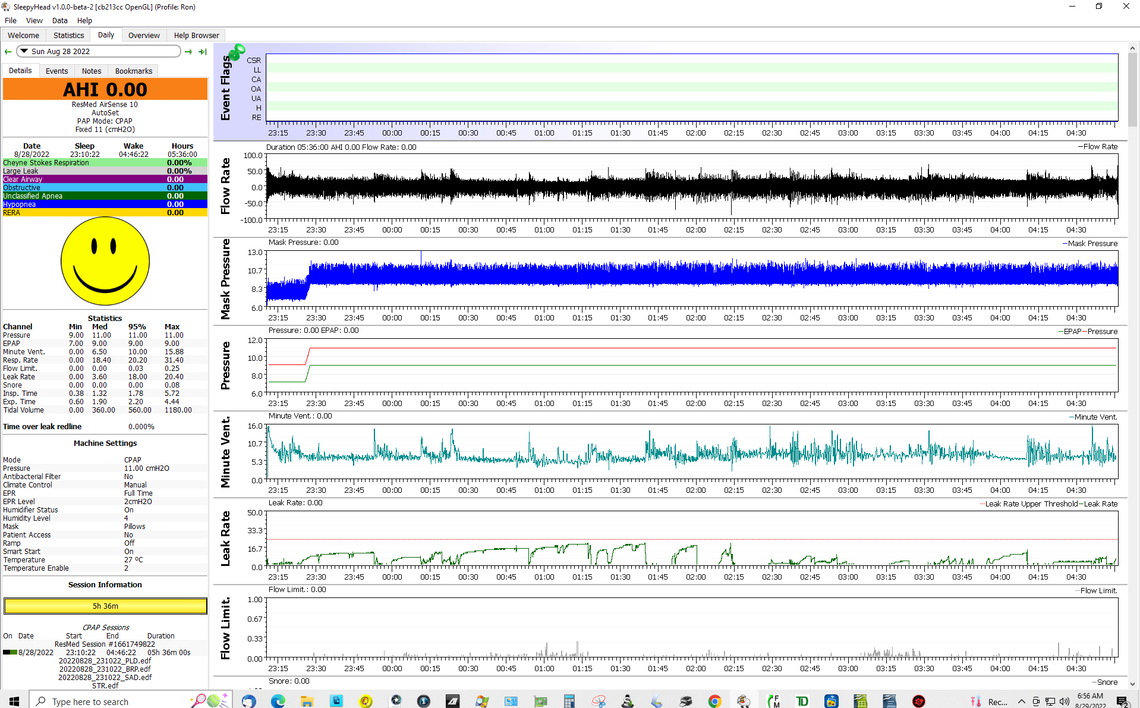I just transitioned from a Resmed CPAP machine to a Resmed BiPAP (Airsense10) machine. I was registering 4 to 6 events per hour on the CPAP device, and now after three nights I'm getting 20 events per hour with BiPAP. Why might this be?
Does the BiPAP machine register events differently or more sensitively?
I also changed mask types to from Airfit f20 (CPAP) to Airfit F30 (BiPAP). Could this have changed the number of events?
I feel like the fit is better, I'm sleeping MUCH longer with the mask (4 to 5 hours before under CPAP, 7 to 8 hours comfortably now.)
I was told with CPAP that the goal was under 5 events per hour. Presumably that is still the goal with BiPAP? Or is it?
So what might be going on with the apparent increase in events using a BiPAP with a new (and seemingly better) mask?
17 to 20 events per hour is a little worrisome... or maybe it was always there but the CPAP machine was only partly registering them?
Thanks!
Welcome to the forum. First I think we should clarify the machine types. A ResMed AirSense 10 is actually a APAP, not a BiPAP. ResMed calls their BiPAP machine the AirCurve 10. So do you have an AirCurve 10 or AirSense 10 AutoSet? And what specific CPAP machine did you have before?
Regardless of the type of machine you switched to, the frequency should not be taking such a jump upwards. Do you what pressure the CPAP was set at? And what pressure range the new machine is set at? The standard for treatment is still to be less than 5 and ideally under 1 if practical.
If you can clarify details about your machine and the pressures, I can probably narrow down what the issue might be.
Thanks, and sorry about the inexactitude on my part.
The CPAP machine was "Resmed AirSense 10 autoset" and was set to something like 10 low/ 15 high (if I recall correctly.)
The new BiPAP machine is "Resmed AirCurve 10 vauto" (that's the tag on the carrying case)... but the picture inside suggests that it is part of the AirSense 10 series) (as distinct from another picture that shows the "S9 series" which this is not an example of.)
The manual is for the AirCurve 10. The tag on the bag supports it being the "vauto" model.
The report screen shows 8.8 low and 12.8 high (which I presume is based on the recent sleep study I did. My understanding is that that is exhale and inhale maximum pressure? I recall that the sleep technician told me that my max pressure to open my airway was about 13 (what are the units we are talking about by the way?)
I did achieve around 5 events per hour with the old machine. The new one has produced three nights of 20, 20 and 17 on first three nights of use).
In spite of that, I am sleeping better because the new airfit F30 mask is so much more comfortable without the pressure on my nose bridge.
Does that provide you with helpful info? Thanks!
Ok, I know which machines you are talking about. Was there a reason why you were switched from the AirSense 10 AutoSet to the AirCurve 10 VAuto?
On the AutoSet 10 a setting of 10 for a low and 15 for a high is fairly standard. The units are manometer readings of cm of water. The same units are used for both types of machines. The AutoSet should also have had a EPR ore (Expiratory Pressure relief) setting as well. Commonly they are set to 3 cm, which means the pressure is reduced 3 cm on exhale compared to inhale.
The VAuto is a little more complicated. The Maximum Inspiration Pressure (IPAP) can be set up to 25 cm which is 5 more than the AutoSet. The minimum Exhale Pressure (EPAP) can be set as well. In addition the differential between the IPAP and EPAP can be set as to as much as 10 cm. This compares to the AutoSet EPR which is a maximum of 3 cm differential. From the numbers you gave it appears they are not taking advantage of the higher pressure that the VAuto is capable of, so I presume they are using more Pressure Support, which may be 4 cm, which is not much of an increase.
Is there any chance that you have the SD card from the AutoSense 10 still around? If so, then you would be able to download the data (with a PC or Mac and a SD card reader) so you could view all the detail with OSCAR program which is freeware. It would show how many apnea events you were having, the type, and at what pressures. If you do this load the A10 data in first, and then also add your AirCurve 10 data. It can handle them both. Then you will be able to compare what the VAuto is doing compared to the A10. You can also post the daily report screen here for comments. Here is an example of what one from an A10 looks like. In most cases one can determine what is causing the apnea events and then make adjustments to try and address it.
This is from when I first started with the A10 and was having lots of trouble.

"Was there a reason why you were switched from the AirSense 10 AutoSet to the AirCurve 10 VAuto?" I'm a little unclear on that, although I think my inability to get a good seal led to an extremely tight mask which led to an inability to get more than four hours per night.... and it was suggested to me by the fitting technician that the whole new machine was unnecessary and issue might have been resolved by a better mask!!!!
Be that as it may, the old cpap machine was 3G so the doc couldn't see my numbers easily, and for reasons I'm not aware of he suggested that BiPAP might be helpful in my case. I'm not clear on reasoning there, but at least now with the 4G bipap machine I can discuss my numbers with him after he views them remotely. I have scheduled an appointment to do that.
What you are saying I think is "no, events should not be greater under BiPAP than CPAP" which was my basic question.
The doc said that people's prescription does sometimes change, and so I accepted that the lower pressure (13 or 12.8) might reflect the new finding in the sleep study. But I think you are suggesting that in fact the lower inhalation pressure might be creating more events.
And I'd add that I think that my previous CPAP inhalation pressure was actually 18, not 15, which is substantially higher than the 13 or 12.8 that my new machine is set at. Perhaps that explains the high events/hour with the new machine. I'll discuss it immediately with my doctor. I'm quite comfortable with a higher pressure, and I was a little surprised that my recent study came back with just a 13 recommendation.
Of course I worry that if the pressure goes up, then the tightness has to increase, and then I won't be able to tolerate the mask for as many hours. But I'll cross that bridge if the doctor recommends increasing the pressure at least to the level that the previous sleep study from 5 years ago put me at, around 18 (if I recall correctly).
Thanks for the info, and for the manual which I'm reading with interest.
If you are going to meet with your doctor or technician you should be sure to bring your SD card with the detailed data on it for them to review. Make sure you have a SD card in the machine that is collecting data, or it will be forever lost. It only needs a 4 GB card, but I believe up to a 32 will work.
Unfortunately the data that is sent by WiFi is very limited. You will be able to see pretty much the same thing by looking at the sleep report on the machine itself. The data you can download with OSCAR is much more detailed. If you could post a screen from OSCAR I could determine much more about how your machine is set up, and what the problem might be.
Do you know the breakdown of your total AHI? How much is obstructive (OA events), and how much is central apnea (CA events). They are quite different issues. Most of my events are CA or central apnea events. You can see them as the magenta flags in the screenshot. OA events for me are less frequent. They are the light blue ones. I have progressed from that screenshot I posted above to much better outcomes more recently, like the one shown below.
